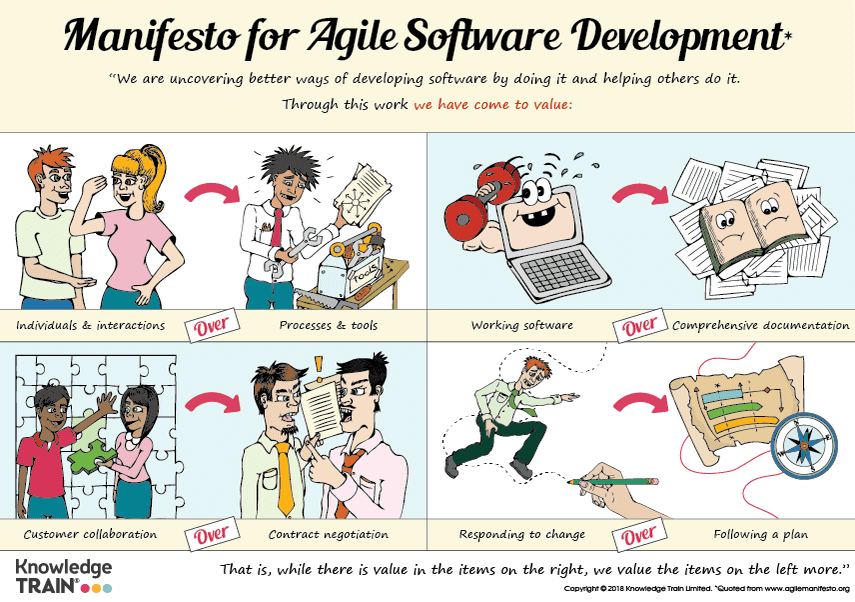
What is the Agile Manifesto?
Written in 2001, The Manifesto for Agile Software Development was created by a small group of software development luminaries who gathered to discuss how to solve some of the issues plaguing the software development industry.
Detailed within are the 12 Agile Principles and 4 Agile Values. These ideas were created to address the inefficiency of existing software development methods which relied heavily on cumbersome documentation procedures and other unhelpful processes.
What the authors did not predict is the impact this document would have beyond the software development industry. Today, businesses in every industry from public relations to advertising make use of Agile in one way or another. That is because the authors of the Agile Manifesto created simple guidance that benefits both business owners and employees.
Agile aids product development by stripping away unproductive processes and choosing to focus on activities that directly contribute to aiding development.
In doing so, Agile not only speeds development and aids the implementation of creative solutions but indirectly benefits workers by making the entire process easier, less stressful, and more rewarding.
These Agile ideas are still used today in contemporary agile project management methods. If you choose to take an agile project management course for example, you’ll notice the themes and principles therein closely resemble the ideas of the Agile Manifesto.
While the implementation of the agile framework may vary depending on which industry-specific methodology you are studying, understanding why the Agile Manifesto was written and why it is still relevant today is an ideal way to start your agile education!
The 4 Agile Manifesto Values
The 4 Agile Values demonstrate how Agile differentiates itself from the traditional methodologies used to manage projects:
Individuals and interactions over processes and tools
People respond to business needs and drive the development process, not tools. Tools are, by their very nature, less responsive to change and unable to meet customer needs.
Working software over comprehensive documentation
Agile is about streamlining rather than eliminating documentation. Documentation has its’ value but should never be prioritized over the product.
Customer collaboration over contract negotiation
In traditional project management, customers dictate requirements for a product before work starts and have little to no interaction with developers. Agile however, considers the customer to be an integral member of the development team
Responding to change over following a plan
Agile works in short development iterations. This short timescale allows for changes to be implement quickly and cost-effectively. Agile sees change as a way to improve a project.
The 12 Agile Manifesto Principles
While the 4 Agile Values provide project managers a rough guide on how to understand the Agile mindset, the 12 Agile Principles give instruction on how to use the Agile framework to deliver high-quality products successfully and consistently to end-users.
The following is taken from the Agile Manifesto.
- Our highest priority is to satisfy the customer through early and continuous delivery of valuable software.
- Welcome changing requirements, even late in development. Agile processes harness change for the customer’s competitive advantage.
- Deliver working software frequently, from a couple of weeks to a couple of months, with a preference to the shorter timescale.
- Businesspeople and developers must work together daily throughout the project.
- Build projects around motivated individuals. Give them the environment and support they need and trust them to get the job done.
- The most efficient and effective method of conveying information to and within a development team is face-to-face conversation.
- Working software is the primary measure of progress.
- Agile processes promote sustainable development. The sponsors, developers, and users should be able to maintain a constant pace indefinitely.
- Continuous attention to technical excellence and good design enhances agility.
- Simplicity—the art of maximizing the amount of work not done—is essential.
- The best architectures, requirements, and designs emerge from self-organizing teams.
- At regular intervals, the team reflects on how to become more effective, then tunes and adjusts its behaviour accordingly.
The Agile Alliance
The Agile Alliance refers to the original 17 signatories of the Agile Manifesto. Among them were experienced programmers, IT industry experts and researchers.
Of these 17, many went to adapt Agile to suit other industries, or perfect the methodology in ways they saw best such as Kent Back (Extreme Programming), Jim Highsmith (Adaptive Software Development) and Jeff Sutherland (Scrum), to name a few.
Is the Agile Manifesto still relevant?
Despite industry changes and technological improvements, the Agile Manifesto’s flexibility, adaptive nature, and liberal use of common-sense makes it just as relevant today as it was more than two decades ago.
Beyond the many agile methods and frameworks, Agile is a mindset and a philosophy. It sets out some guiding principles and values, not rules. Being ‘agile’ doesn’t require that you use any particular agile tool, process or framework. The principles and values of Agile simply encourage business owners and developers to use a little common sense in their approach to project development.
At the end of the day, the Agile Manifesto is no more than a document which describes how successful teams can better work together.
Agile Manifesto infographic
Discover the key values of the Agile Manifesto with this colourful infographic! If you’re an agile project manager, or a developer on projects, the manifesto will inform the way you work.
Download and print a free poster version. Put it on the wall in your workplace to help your team learn the four values of the Manifesto for Agile Software Development. Ideal for anyone working on agile projects!
Feel free to use this graphic on your website, but please link back to this page so others can enjoy our free resources.

